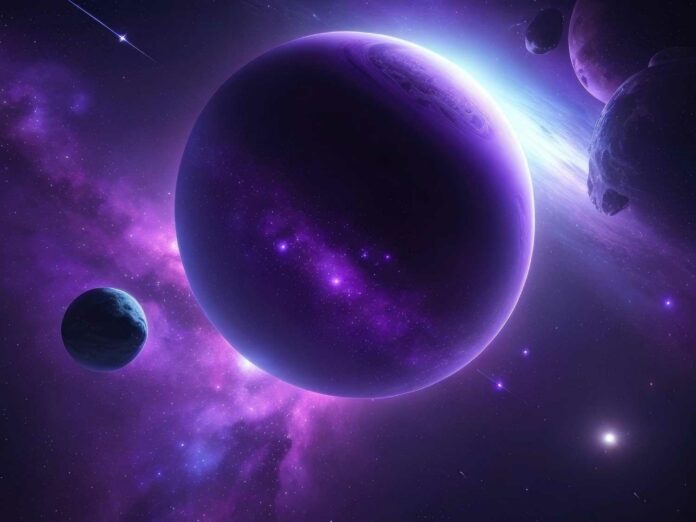We are accustomed to seeing green everywhere on Earth, from extensive forests to the plants that grow in our homes. Chlorophyll is a pigment that organisms employ in photosynthesis to create oxygen, giving things their green color. On the other hand, an Earth-like planet circling a different star would appear somewhat different.
Such a planet might be dominated by microorganisms that don’t need oxygen or visible light rather than being covered in green plants. These bacteria may fuel their photosynthesis with infrared radiation, which is invisible to humans. Since these bacteria frequently possess purple pigments, unlike chlorophyll-based organisms, their environment would be distinctly purple.
Cornell University researchers have discovered that these purple worlds can be found with cutting-edge ground—and space-based observatories. Scientists can identify potentially habitable planets outside of our solar system by examining the distinctive “light fingerprint” these microorganisms emit. This research opens new avenues for comprehending the diversity of life in other worlds.
Lígia Fonseca Coelho, a postdoctoral associate at the Carl Sagan Institute (CSI) and the study’s first author, said, “Purple bacteria can thrive under a wide range of conditions, making it one of the primary contenders for life that could dominate a variety of worlds.”
It is essential to create a database of signs of life to ensure that our telescopes don’t miss life if it doesn’t look exactly like what we encounter daily.
To date, astronomers have discovered more than 5,500 exoplanets. It includes more than 30 potentially Earth-like planets.
Exoplanets within the habitable zones of their stars are being studied by planned observatories such as the Extremely Large Telescope and the Habitable Worlds Observatory. These are places on Earth where conditions could support liquid water on the planet’s surface, an essential component of life as we know it. Researchers will examine the chemical composition of these worlds to find indications of possible life and habitability.
A group of scientists from Cornell University’s Carl Sagan Institute (CSI) is drawing inspiration from Earthly life to enhance their understanding of what to seek. Experts like Stephen Zinder, an emeritus professor of microbiology, and William Philpot, an emeritus professor in the School of Civil and Environmental Engineering, are part of this multidisciplinary team.
They’re working together to compile a list of the colors and chemical signatures different minerals and species would display when their light is reflected off an exoplanet. This understanding will be essential for deciphering the information gathered by upcoming telescopes and choosing worthy candidates for more research.
Coelho set out to gather and grow samples of more than 20 different kinds of purple bacteria. These bacteria are present in various environments, including deep-sea hydrothermal vents and shallow seas along coastlines. While some samples were collected during a summer course at the Marine Biological Laboratory, others were collected off the coast of Cape Cod from a pond on the campus of Cornell University. Furthermore, lab cultures from partners at the University of Minnesota were utilized.
Contrary to their name, purple bacteria exhibit a range of colors, including red, brown, orange, and yellow. These colors are caused by pigments related to those in carrots and tomatoes. These bacteria use a less complex type of photosynthesis that doesn’t produce oxygen to survive in situations with low-energy red or infrared light. They most likely thrived on early Earth before photosynthesis from plants emerged. These creatures would be particularly well adapted for planets circling our galaxy’s many red dwarf stars, which are cooler.
“They already thrive here in certain niches,” Coelho said. “Just imagine if they were not competing with green plants, algae, and bacteria: A red sun could give them the most favorable conditions for photosynthesis.”
After examining the hues and patterns of light exhibited by purple bacteria, the researchers created computer simulations of planets that resemble Earth but have distinct habitats and clouds. Both moist and dry purple bacteria produced vibrant evidence of life in these simulations.
“If we find purple bacteria on a frozen Earth, an ocean world, a snowball Earth, or even a modern Earth orbiting a cooler star,” said Coelho, “we now know how to look for them.”
Finding a “pale purple dot” on a planet in another solar system would prompt scientists to closely study the Earth to ensure the color isn’t coming from something else, like colorful minerals.
Co-author Lisa Kaltenegger, CSI director and associate professor of astronomy in the College of Arts and Sciences, said, “Detecting life is so difficult with current technology that if even single-celled organisms are found in one place, it would suggest that life must be widespread in the cosmos. That would revolutionize our thinking about the age-old question: Are we alone in the universe?”
“We are just opening our eyes to these fascinating worlds around us. Purple bacteria can survive and thrive under such a variety of conditions that it is easy to imagine that on many different worlds, purple may be the new green.”
Journal Reference:
- Lígia Fonseca Coelho, Lisa Kaltenegger, Stephen Zinder, William Philpot, Taylor L Price, Trinity L Hamilton. Purple is the new green: biopigments and spectra of Earth-like purple worlds. Monthly Notices of the Royal Astronomical Society. DOI: 10.1093/mnras/stae601
